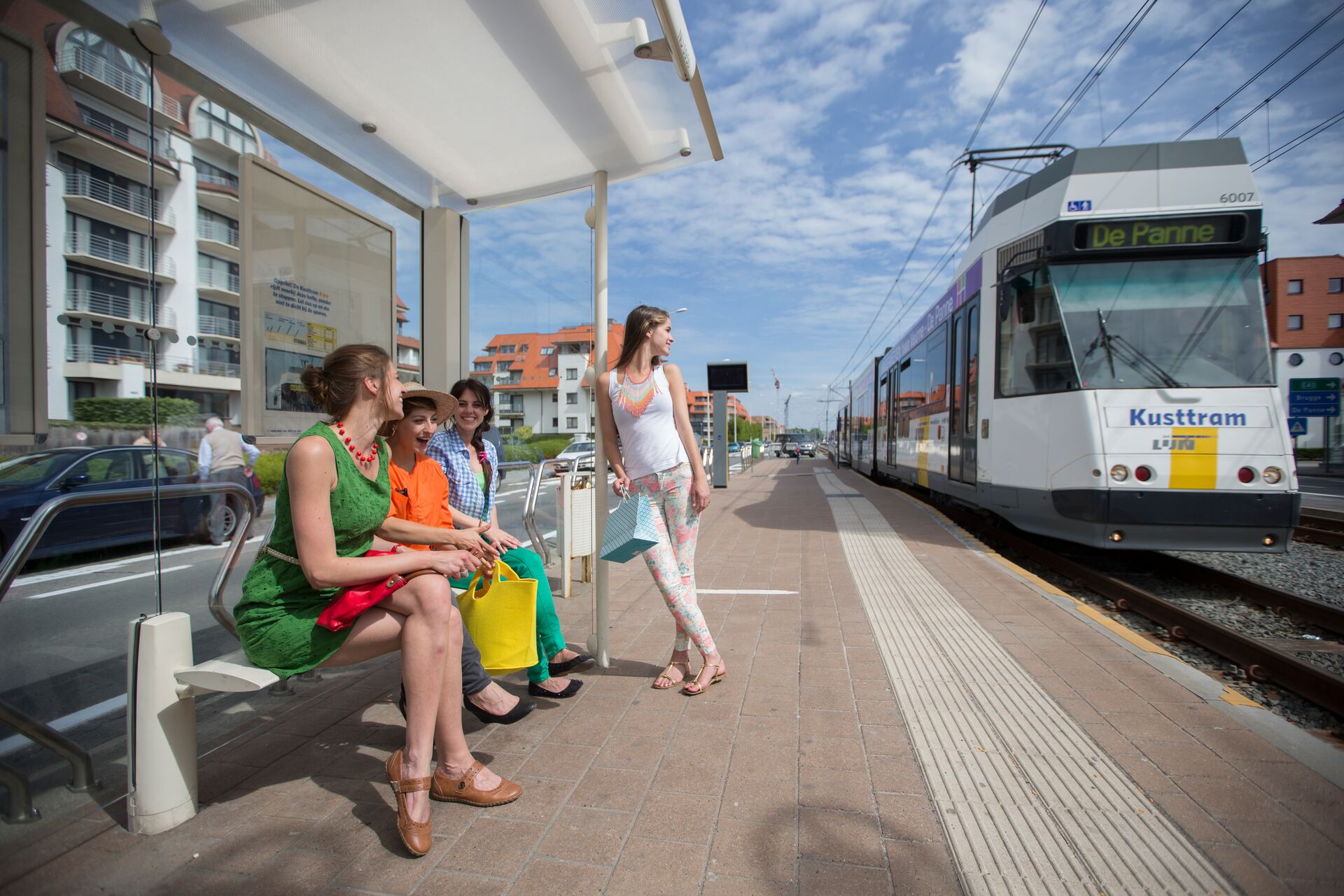The Flemish coast is a multi-faceted paradise. Encompassing 67 kilometres of fine sand, sea and dunes, art and culture, food and drink, history and heritage, shopping, surfing and much more. The North Sea beach stretches from the Dutch to the French border. The Coastal Tram, the longest tram line in the world, takes you on a four-day trip from east to west. We start in Knokke-Heist and end up in De Panne.
It is all but impossible to resist the lure of the North Sea. This trip to the Flemish coast begins as you would expect. Briefly glancing at the horizon, relishing the salty sea air and the frothy waves. Now you’ve got the gist, let’s begin our journey of discovery. It starts in...
Day 1
Knokke-Heist
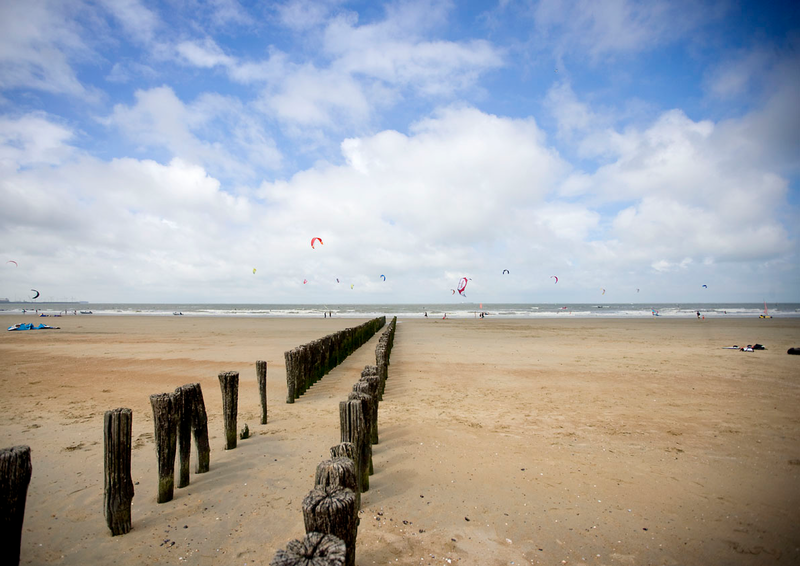
A fashionable seaside resort with the allure of a city
Knokke-Heist is a place with great appeal. There are hundreds of boutiques, from refreshingly simple to dizzyingly exclusive. The renowned top brands show off their flagship stores in the golden shopping triangle of Lippenslaan, Dumortierlaan and Kustlaan. But a walk through Knokke has much more to offer. You’ll pass dozens of quirky art galleries and striking villas scattered around the town. One hundred metres inland, you’ll find yourself in the midst of the villa quarters with their characteristic orange roof tiles. Many of these architectural gems have a name plate, which has been a tradition in the seaside town for a hundred years.
However, Knokke offers much more than this grandeur. It is home to large areas of unspoilt nature. If you want to explore it, you can walk along the sea wall to the vast Zwin Nature Park, a nature reserve that follows the rhythm of the tides and seasons. It is home to an exceptional wealth of fauna and flora. Extensive hiking trails, a barefoot trail and a hut trail lead you through lots of experiential sites or huts on the domain. Don’t forget your binoculars! The Zwin Nature Park is an 'international airport' for migratory birds. Every year, many thousands of birds land there to breed, spend the winter or look for food. This nature park offers a completely different perspective of the Flemish coast.
At Knokke train station, we get on at the Coastal Tram’s very first stop. It follows the entire length of the Flemish coast: 67 kilometres long with 67 stops. This makes it the longest tram line in the world and a fabulous way to explore the Flemish North Sea coast.
Zeebrugge
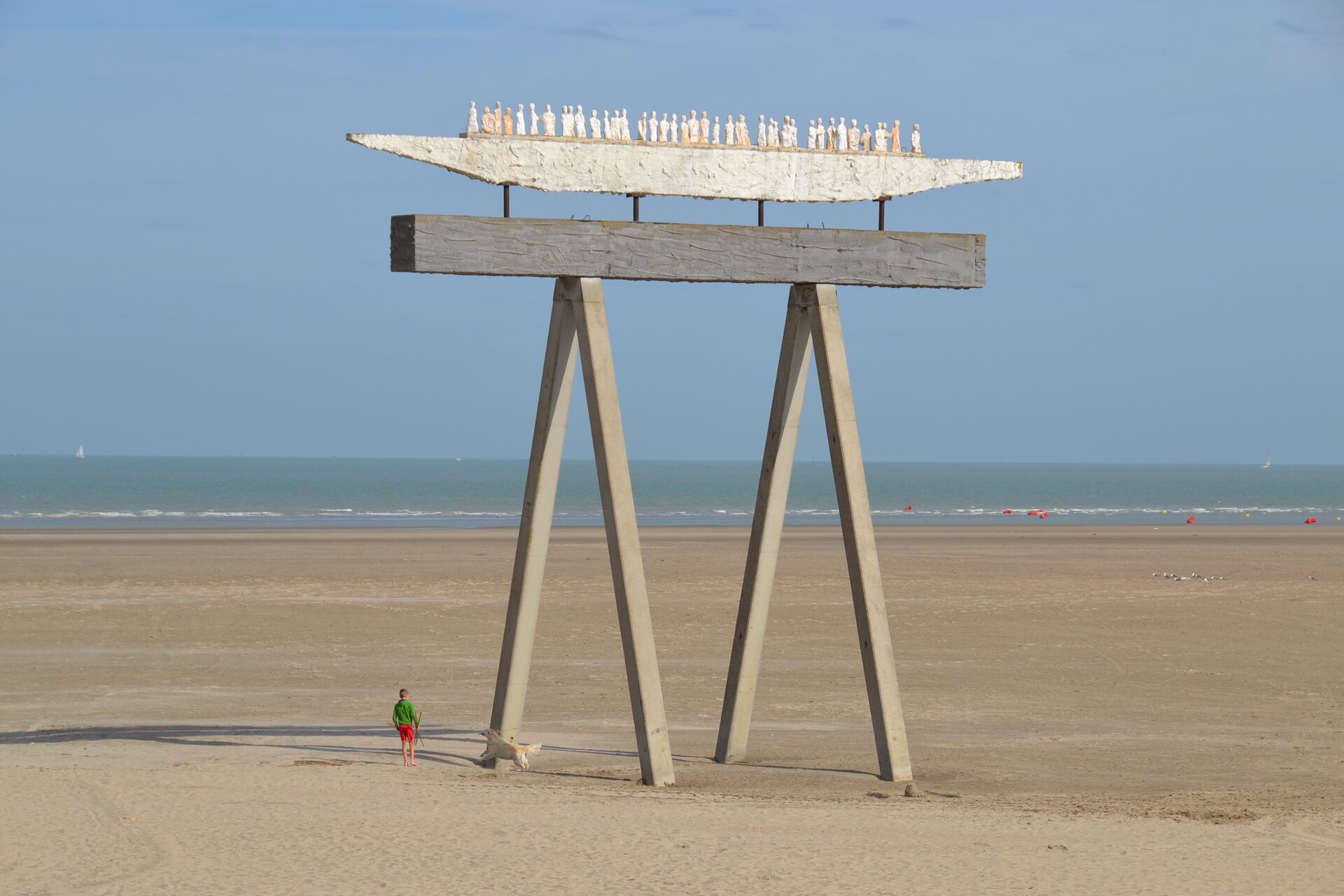
Artistic fishing capital
Our next stop is called Zeebrugge. This cosy harbour town is a borough of medieval Bruges. The Coastal Tram drops you off in the middle of the old fishing port, where you can still find a handful of charming fishermen’s pubs. Your frothy glass of Belgian beer is accompanied by a small portion of fresh, unpeeled shrimps. It doesn’t get more authentic than that. From there, the former fish market (Vismijn) is just a stone’s throw away. It housed the maritime theme park Seafront for 20 years. In anticipation of a completely new development, it is currently home to a temporary project brimming with creativity, dynamism, inspiration and lots of activities. Pop in and enjoy a break; there’s something for everyone.
After this maritime spectacle, we leave the harbour behind us. We now set off on foot, along the largest stretch of beach of the entire Flemish coast. At the beginning of this walk you pass by a special sculpture: a 3,000-kilo boat that rests on supports 10 metres high. The artwork appears to float just above the breaking surf. From a distance, a mysterious figure gazes at the scene: The man who saw the boat in the air. This impressive statue is just a taster of what’s to come. Further on you will also find traces of Beaufort, a large-scale art event that drops its anchor at the Flemish coast every three years. Contemporary works of art are erected on and around the sea walls, beaches and dunes. Under the name Beaufort Sculpture Park, forty works of art have acquired a permanent place in this permanent outdoor museum.
Day 2
Blankenberge
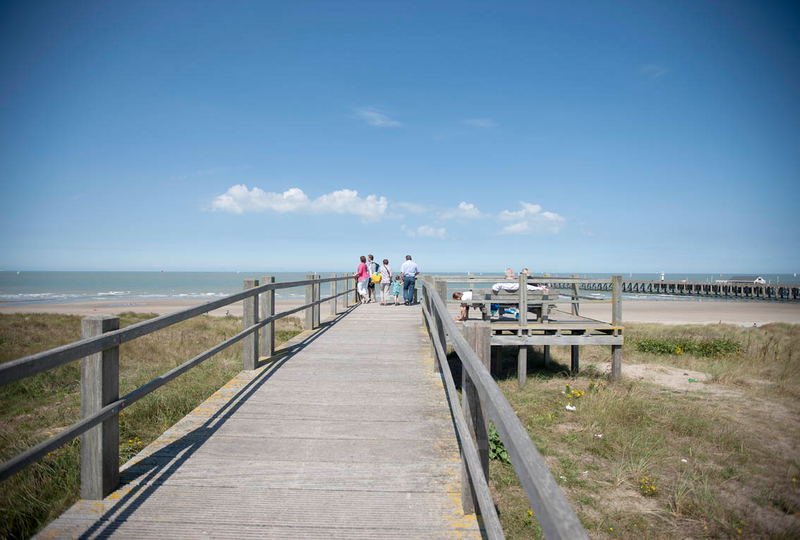
Surfing from pier to the fin de siècle
After this artistic encounter, if you continue on the long beach, you will end up in Blankenberge. As soon as you walk up the sea wall, an impressive structure emerges. The Belgium Pier is a remarkable piece of heritage. This 350-metre-long bridge seems to disappear into the water. A walk on this pier makes you feel one with the North Sea. Taste the salty air, get carried away by the ebb and flow, feel the power of the elements. A spectacular view in all directions, while a brisk sea breeze blows the cobwebs away.
If the weather conditions are right, you will probably see many surfers. This is one of the most famous surfing spots on the entire Flemish coast. Even if the sea is calm elsewhere, there’s a good chance the waves will be perfect for surfing here.
After that, we head off to the city centre. This place enjoyed some golden years in its heyday around the transition from the 19th to the 20th century, just like many other seaside resorts on the Flemish coast. This period is referred to as the fin de siècle or the belle époque. These terms literally mean “the end of the century” and “the beautiful age”. An extravagant period characterised by peace, financial opportunities and great architectural achievements. In Blankenberge, it heralded the creation of the Belgium Pier, the casino and a handful of large hotels. Many of the characteristic coastal villas in the dune zone were also built at the time. The Belle Epoque Centre tells the story of Blankenberge in that extraordinary, seemingly carefree time. An interactive exhibition immerses you in that nostalgic atmosphere with posters, postcards, fashion, photos, film material and several stunning tile tableaux.
We have already indulged ourselves in plenty of culture. Now your taste buds deserve a treat too. Settle down in a beach chair, feel the sand between your toes and enjoy a delicious Belgian beer while the sun goes down on the North Sea.
De Haan
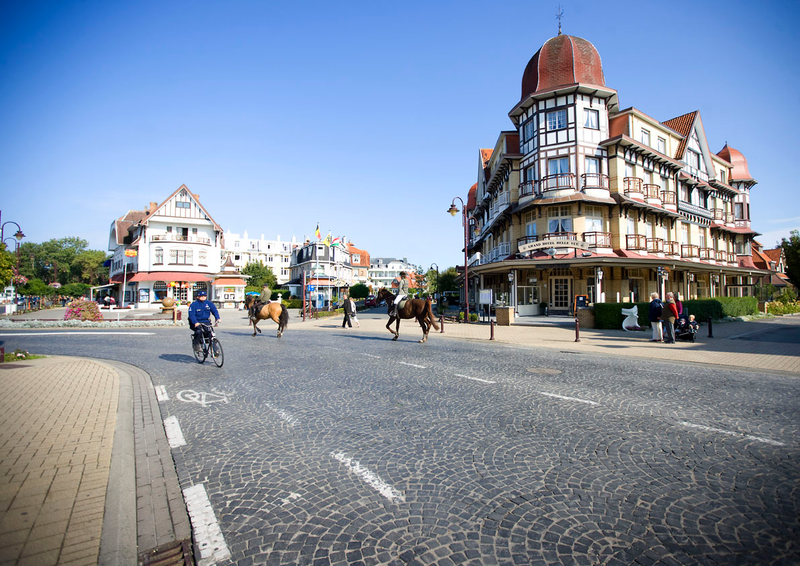
Gem of the belle époque
A short ride on the Coastal Tram will take you to Wenduine, a borough of De Haan. Once you’ve got both feet firmly on the ground again, you’ll see Benjamin. That’s the name of the large, fairy-tale sculpture of a little boy. He stares straight ahead, lost in his thoughts, a pair of donkey ears on his head. This is another fine example of Beaufort Sculpture Park.
It’s now time to explore De Haan. This seaside resort is known among other things for its stately Concessie villa quarter. This area, spanning 50 hectares, lies right between the sea and the tram line. It boasts many characteristic coastal villas. A beautiful view with considerable appeal, also for some of the world’s greats. In 1933, Albert Einstein spent a summer here, in Villa Savoyarde. He also travelled to De Haan on the Coastal Tram, from Ostend station. The passage of this absolute genius is still an important page in the history books of De Haan. The Concessie, where he stayed, is a protected landscape to this day, which means its unique, original character is preserved.
After a visit to this special quarter, the Coastal Tram takes a few minutes to reach another highlight. The Duinbossen or dune forests, one of the green gems along our coast. The 152-hectare domain includes an open dune landscape as well as vast wooded dunes. It’s a wonderful place to walk and play, with the North Sea within easy reach.
Bredene
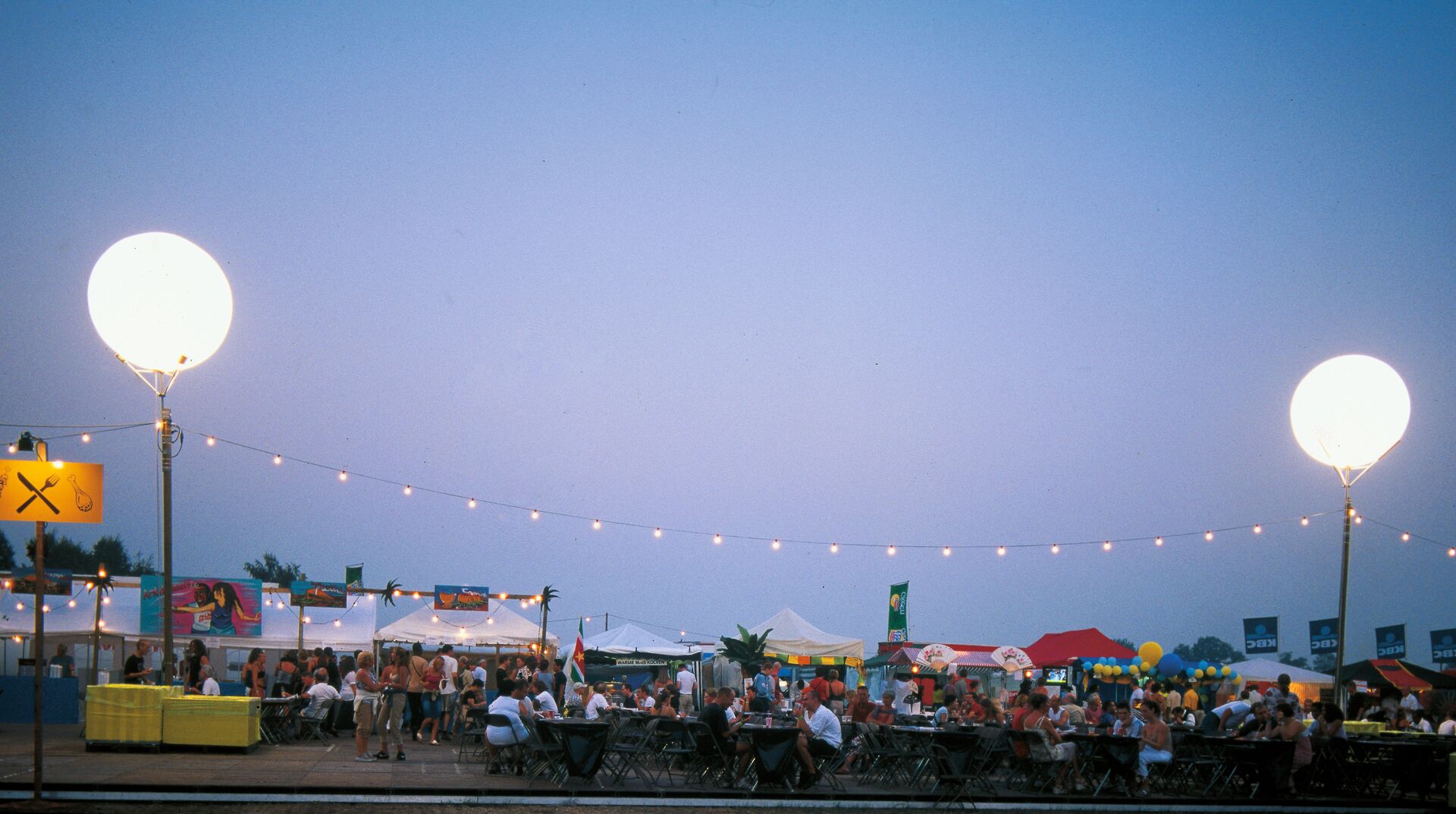
Unspoiled North Sea beach
In the meantime, our journey takes us to yet another seaside resort. Bredene is the ideal place to enjoy some fresh air. It is the only place on our coast where all the natural assets of the North Sea are on show. The undulating sand dunes with their beach grass merge seamlessly into the beach and the lively North Sea, without the need for a sea wall. For those who like to be one with nature, here you will also find the only nudist beach on the Flemish coast.
Day 3
Ostend
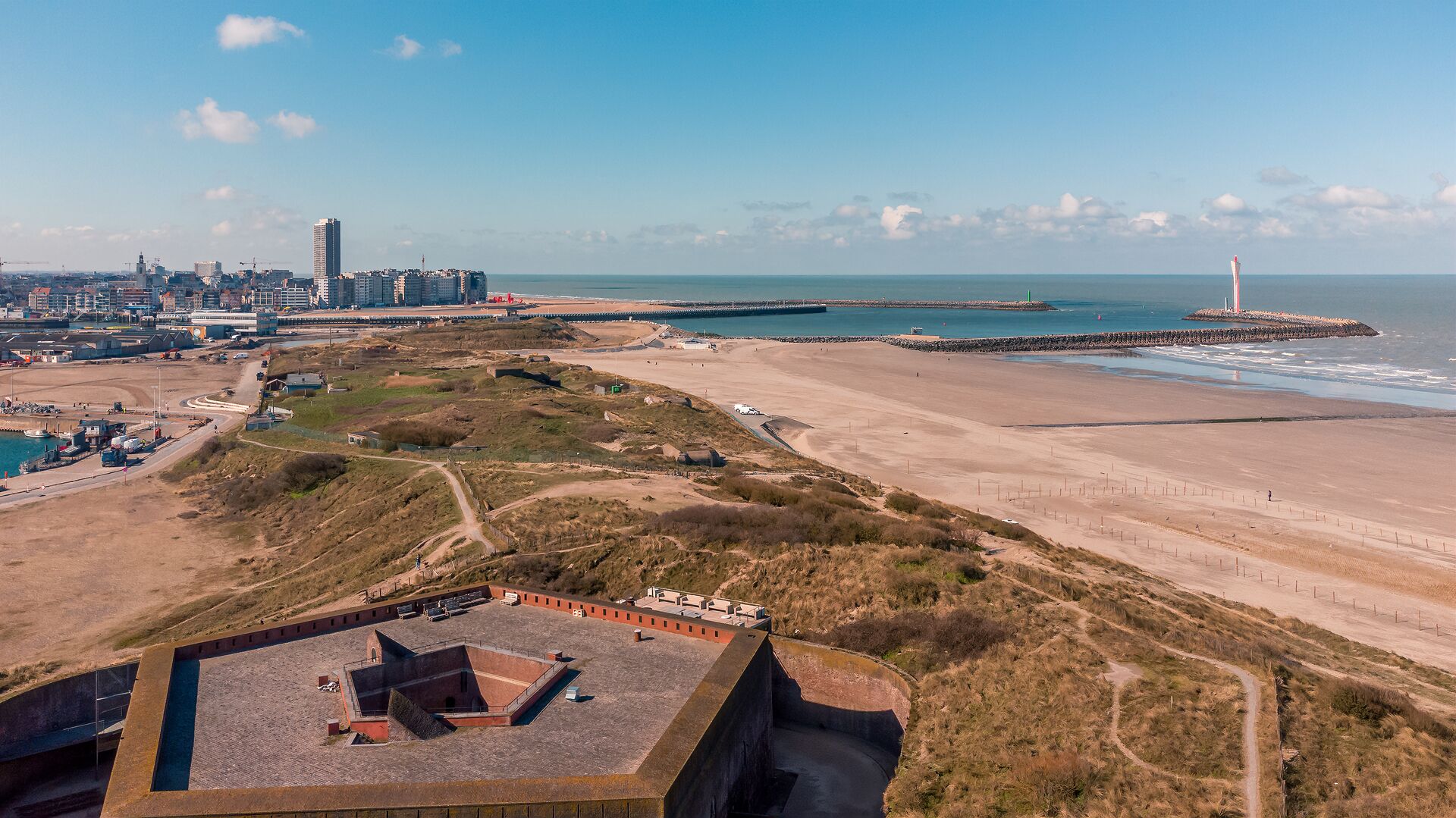
(artistic) Queen of seaside resorts
Our journey continues in the direction of Ostend: “the Queen of seaside resorts”. Along the way we pass Fort Napoleon, a former fort with an unlikely history. Here’s a brief summary. Napoleon Bonaparte had this pentagonal fortress complex built in the dunes in 1810. The aim was to avert a possible British attack on Ostend port. After Belgian independence in 1830, it served as a barracks for the Belgian army. During the Franco-Prussian war (1870-1871) it was a refuge for French soldiers. And during both World Wars, the Germans took control of the fort. In World War I, it was an important part of the coastal defence line, and in World War II, it served mainly as a barracks.
These centuries of history and stories skilfully unfold in Fort Napoleon. It guarantees an exciting visit for all ages. The storytelling trail and temporary exhibitions tailored to children take you on an imaginary journey.
Once you leave this remarkable fort, our journey along the Flemish coast advances one step further. Without even thinking about it, we have now arrived in Ostend. An entrancing place where the tough life of fishermen and a fashionable urban ambiance go hand in hand. Bustling with art and culture and splendid Art Nouveau architecture. From Fort Napoleon you enter the town via the free ferries.
They drop you off at the Visserskaai. The street name gives it away, you are in the historic fishing harbour. Places to explore include the Vistrap, an outdoor fish market that dates back to the 19th century. It’s worth stopping to pick up some fresh North Sea fish or seafood. A handy tip for those who want to buy a portion of shrimps: don’t search for the Dutch word “garnalen” (shrimps) here, the signs are in the local dialect. And here these delicacies are called “geirnoazen”. But, as you will soon be able to testify, they are delicious in any language. If you walk a little further, you will pass by Rock Strangers, a collection of bright orange sculptures up to 20 metres high. These also belong to - you guessed it - Beaufort Sculpture Park.
When evening beckons, Ostend residents head to one of the many restaurants. A dish of hand-peeled brown shrimps, served just as they are, is always a delicacy. Without shrimp croquettes with their crispy crust and creamy filling, our culinary culture would not be the same. A piece of fresh fish is such a treat. And don’t forget the mussels! They are always a hit. The choice is yours.
One thing is certain: Ostend has a lot to offer. Let’s start with the artistic patron saint of this vibrant town: James Ensor (1860-1949). Born and bred in Ostend, he was a giant of the modern arts. A virtuoso of impressionism, an outstanding colourist and an artist with an amazing quirky style. His oeuvre, which is experimental and recognisable at the same time, is full of humour, satire and the grotesque.
Ensor was born in this city and drew his final breath 89 years later. His home town had a huge impact on his oeuvre. He grew up in the shop of his parents, uncle and aunt. They sold shells, souvenirs and all sorts of playful items such as carnival masks. Those masks would become a constant in his work. His masterpiece The Intrigue is a prime example. You will learn much more about this story in the James Ensor House. This is the name of the place where the grandmaster spent the last 30 years of his life. It is a museum and visitor centre, which reveals Ensor’s eventful life and influential legacy. You stand where he stood, you sit where he sat.
That journey of discovery about this great artist is also described in Mu.Zee, the museum of modern and contemporary art. It celebrates his work with a beautiful selection. He stands shoulder to shoulder with the oeuvre of his local and contemporary peers Léon Spilliaert and Constant Permeke, other first-class artists.
Ostend
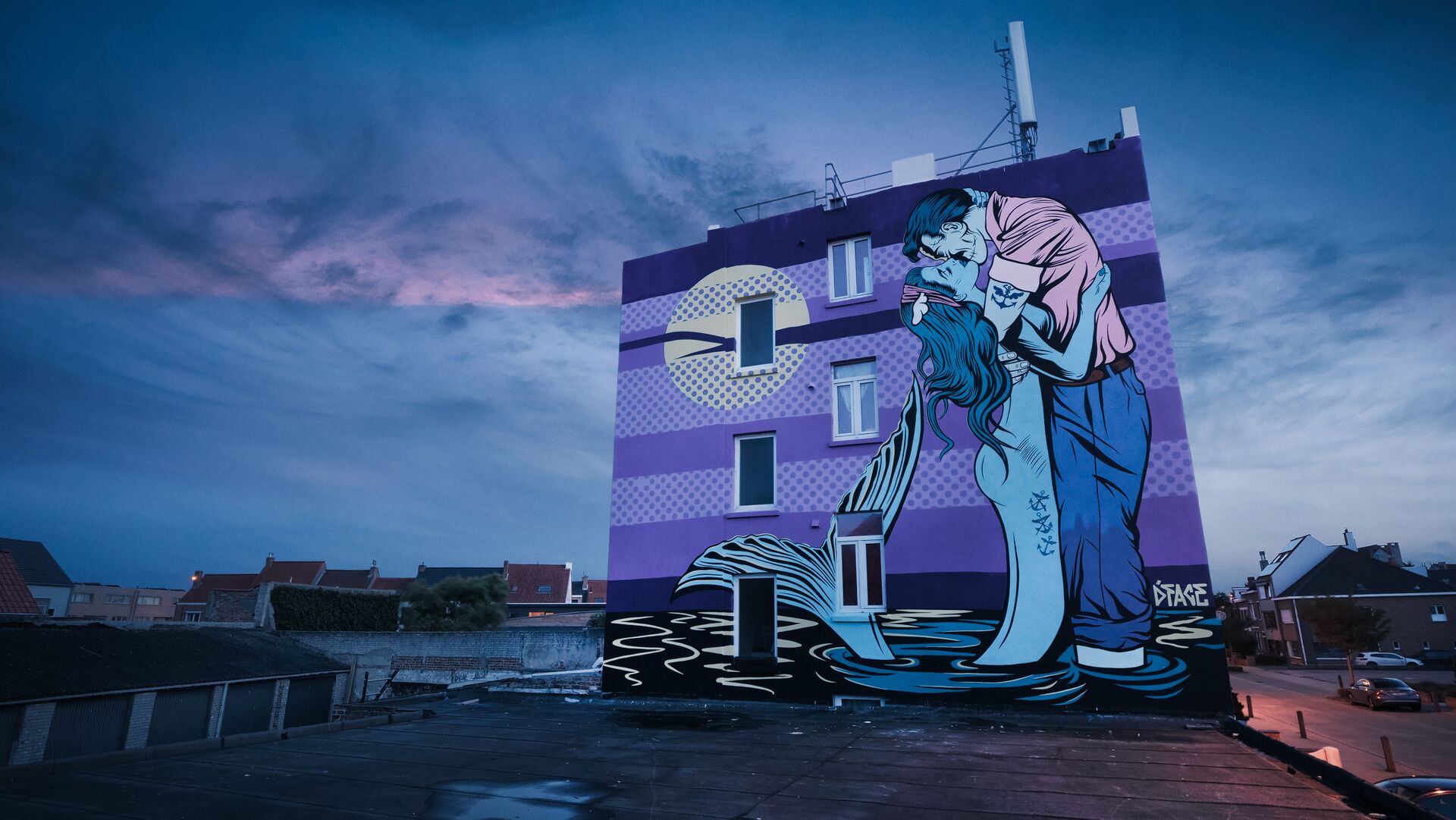
The Crystal Ship
And this magnificence endures. Ensor exerted a special influence on many artistic generations that came after him. It continues to this day, and can be observed in the traces that The Crystal Ship left on the city. Every three years, this vibrant street art festival takes over Ostend. Each time, dozens of artists portray the city from a different perspective. Many of their works have become a permanent feature of the townscape. A walk along all those highlights is definitely worth it.
The Crystal Ship has transformed Ostend forever, but the same applies to the belle époque. On the sea wall you will find some highlights from the transition from the 19th to the 20th century: the eclectic Villa Maritza, the Royal Galleries, the stately Thermae Palace Hotel and the Wellington Race Track.
From the race track, the Coastal Tram takes you to the Atlantikwall Raversyde domain, a unique nature reserve. The varied landscape invites you to take a relaxing walk, and you’ll be rewarded if you do. The domain takes its name from the Atlantikwall, the long line of German defence during both World Wars. There are perfectly preserved remnants of that line to see, with more than sixty bunkers, open and underground corridors, observation posts and artillery positions.
After enjoying the nature and the very interesting visit, we are back at the North Sea beach. Where we see Metatron, a geometric sculpture by the Ostend artist Louis De Cordier. Yes, indeed: thank you, Beaufort Sculpture Park!
Day 4
Middelkerke
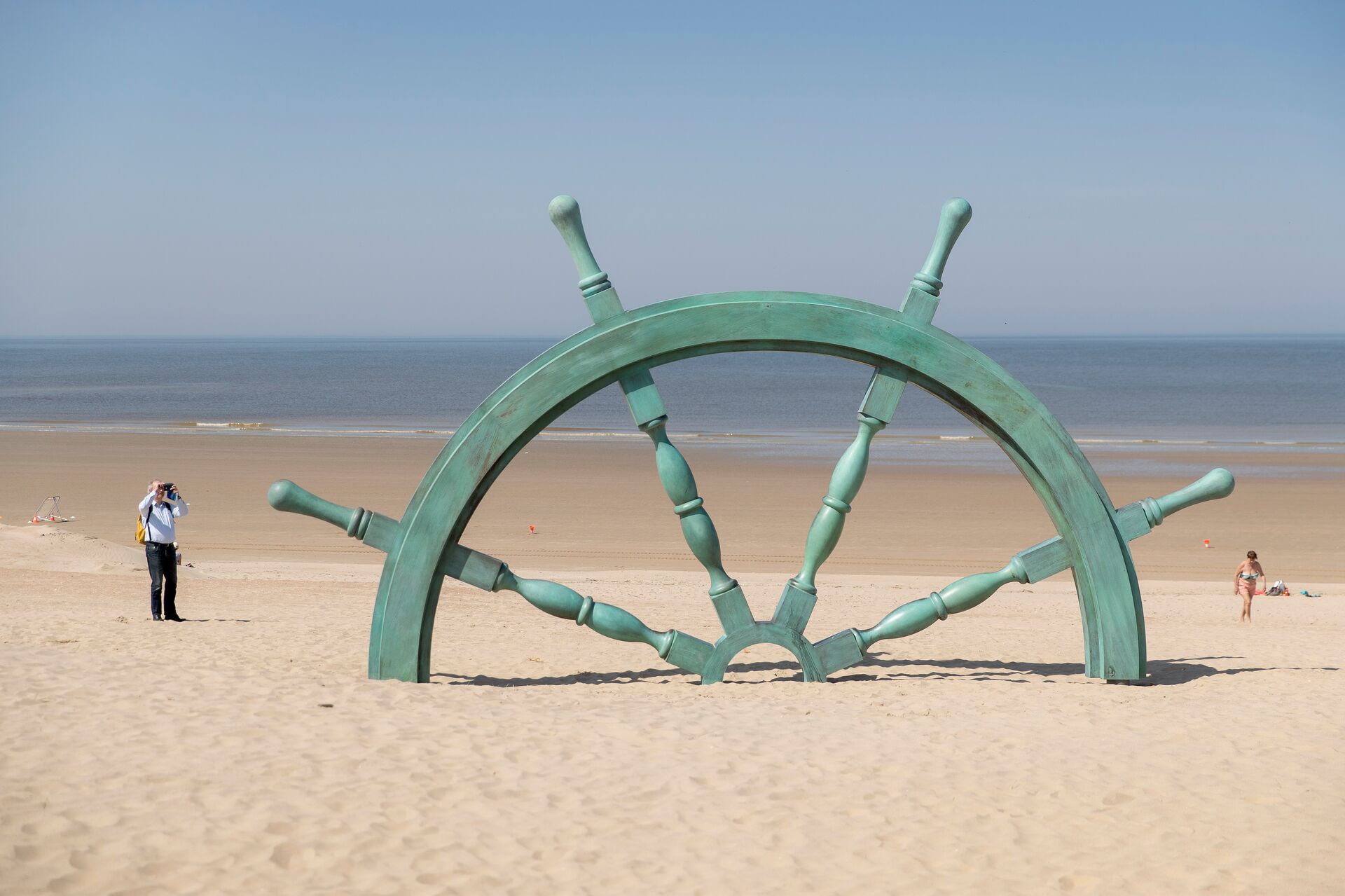
An extra shot of Beaufort and nature
Today we leave Ostend, on foot or by tram. In Middelkerke we immediately come across a rather concentrated piece of Beaufort. Three stunning works occupy a proverbial handkerchief of a stretch of beach. There is the bright yellow, monstrous-looking sculpture Olnetop, which refers to the splashing waves of the North Sea. And Caterpillar + Flatbed Trailer by the famous Belgian artist Wim Delvoye. These sculptures make the link between excavators and Gothic churches. There is the interactive I Can Hear It, two giant horns like those on an old gramophone. The horns point out to sea. A bronze woman has her ear pressed to one of the horns. The other one is unoccupied, so you too can listen to the crashing waves, whistling winds and passing gulls. An incredible, outdoor mini-exhibition.
Just a stone’s throw from this artistic trio, you’ll find the Warandeduinen, the Warande dunes, a 32-hectare nature reserve with highly varied vegetation. In its midst you can explore the Warande Tower, which offers fabulous views of the dunes, polders and the North Sea. From there, a short walk leads you to Villa Les Zephyrs, another pearl from the belle époque. This villa was designed by Henry Van de Velde, one of the standard bearers of Art Nouveau.
Nieuwpoort
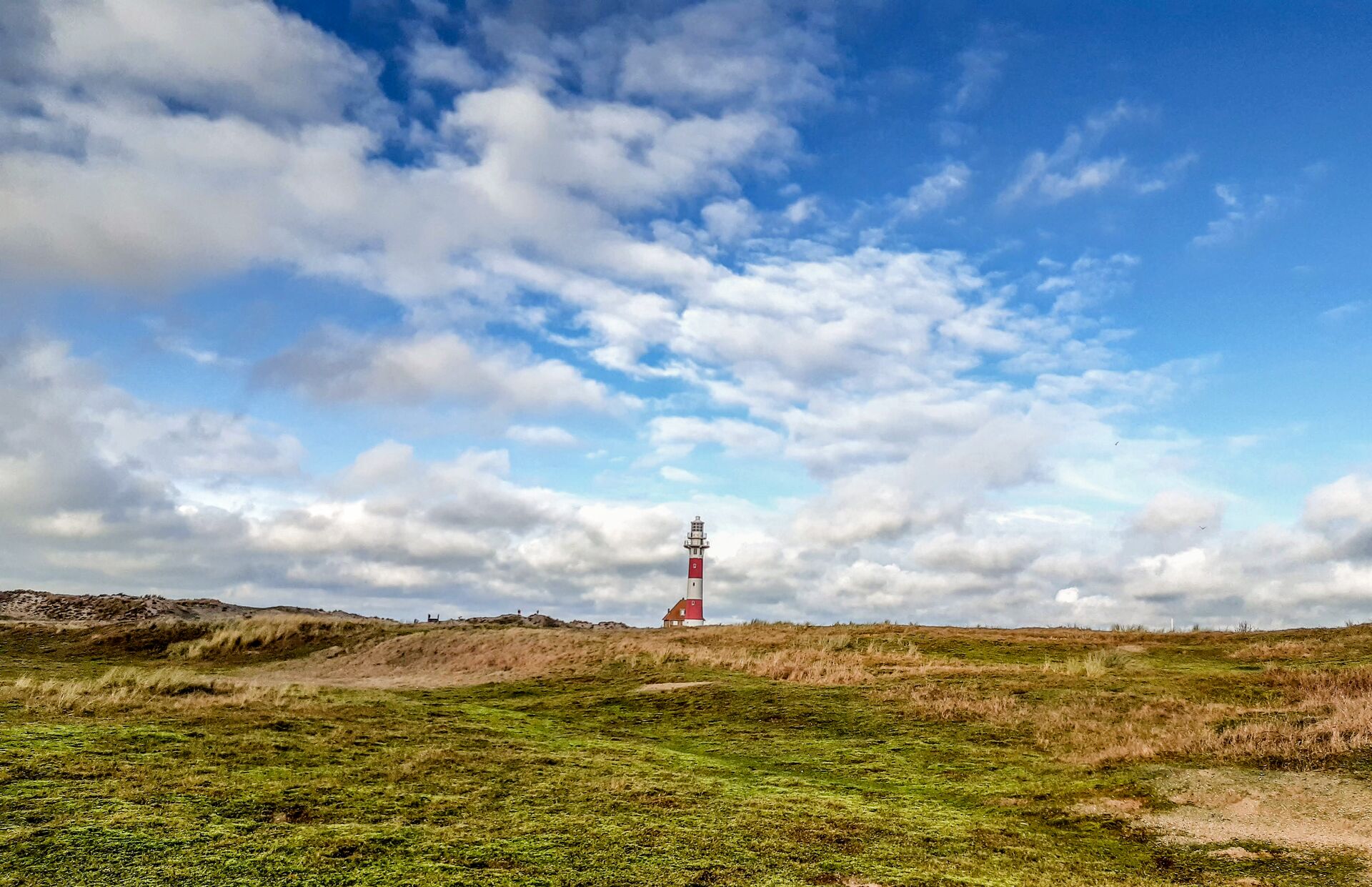
The North Sea meets Flanders Fields
After this little gem, we jump on board the Coastal Tram again. You will notice that the tram suddenly deviates from the coastline for a little while. This is because of the Yser, which flows into the North Sea here. We arrive at Nieuwpoort with the river. This is both a seaside resort and part of Westhoek, an important battleground of the First World War. One part of Westhoek is known worldwide as Flanders Fields. You can learn more about these dark pages of our history in the Westfront Visitor Centre.
As we continue our journey, a giant golden turtle appears on the horizon. And he has a rider on his back. This is Looking for Utopia, another great piece of Beaufort Sculpture Park. And with that we arrive in the centre of Nieuwpoort. Not only is it a seaside resort, it also has a vibrant, up and coming city centre. Fashionistas can be found at the Havenpromenade and Albert I-laan. Weather permitting, you can enjoy a pleasant stroll along the sea wall and the many beach bars. And if you do, there’s no harm in treating yourself to an aperitif.
Koksijde
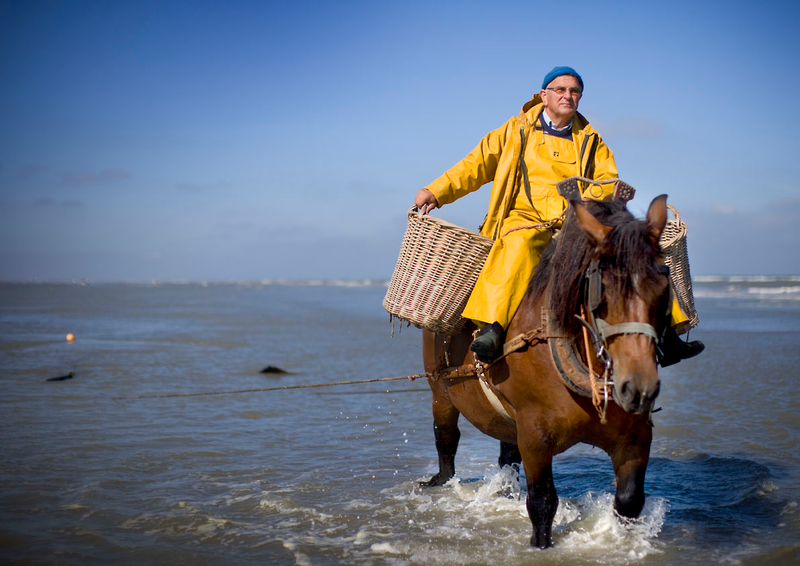
The home of shrimp fishermen
A cold drink might get you in the mood for what’s next. The Coastal Tram takes us to Oostduinkerke, borough of Koksijde. This is where shrimp fishermen on horseback are at home. It is the only place in the world where a centuries-old tradition is still practised. At low tide you see sturdy draught horses appear on the long sandy beach. They are ridden by the fishermen, in their characteristic yellow coats. They wade through the surf with their dragnets, to catch the caviar of the North Sea: the brown shrimp. A tradition that has been part of the Flemish coast for seven centuries. It is no surprise that UNESCO recognises this use as intangible cultural heritage. With a bit of luck, you’ll get a unique culinary experience here. The delicacies are regularly cooked and sold on the beach. You won’t get them any fresher than that.
After being introduced to this piece of intangible heritage, we once again head into nature. We set off for De Hoge Blekker, a nature reserve where you will find the highest dune on the Flemish coast. If you have the time and energy for it, you can explore 18 beautiful hectares of dunes.
De Panne
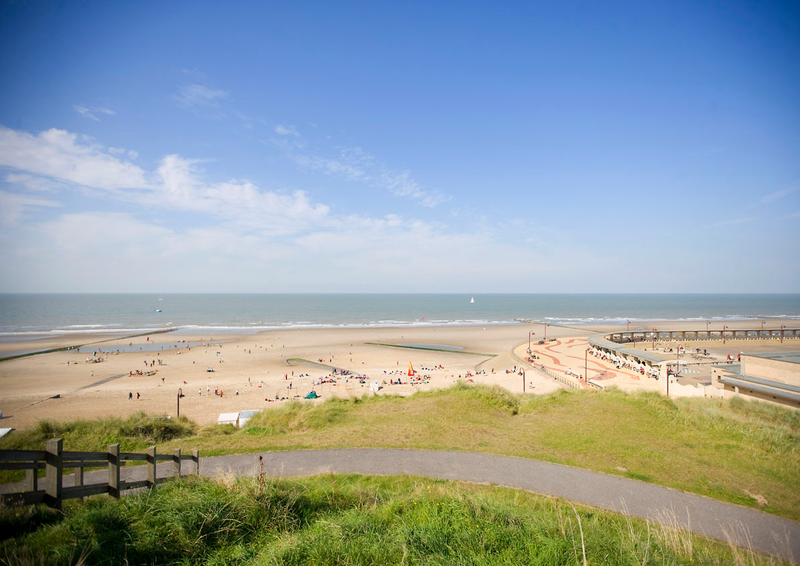
The perfect final chapter
Our journey is slowly coming to an end. The Coastal Tram takes us to De Panne, the northwesternmost corner of our country, nestled against the French border. One more natural beauty to finish off. In Westhoek Nature Reserve you can enjoy Westhoek’s impressive dune landscape. And, if you’re lucky, you might see Scottish Highland cattle or Konik ponies pass by. If you walk from there to the surf, to wave goodbye to the North Sea, you’ll find one last piece of the unforgettable Beaufort Sculpture Park. Just one and a half kilometres from the French border, we see Cast Away, a sculpture by Michael Rakowitz. With this work he explores the history of Operation Dynamo during World War II. In this operation, the allied troops were hastily evacuated from Dunkirk.
On this tour of the Flemish coast, in De Panne we thus encounter one last artistic beacon of Beaufort Sculpture Park. A striking final chapter, although it doesn’t have to be. It could also be the first. Of course, you could take this journey in the opposite direction, or pick out your own highlights. For nature lovers and beach runners, lovers of art and culinary delights, on your own or with the whole family: the Coastal Tram takes you anywhere you want to go, to every highlight along the Flemish coast.
